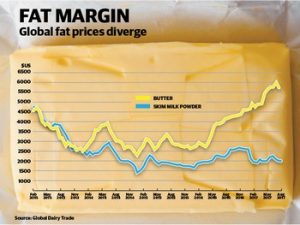Australian dairy farmers say they’re being underpaid for fat, despite a global hike in butter prices.
Global butter prices have surged from $US4000 a tonne 12 months ago to almost $US6000 a tonne today, while skim milk powder has been bogged down at $US2000 to $US2500 since late 2014.
Yet Australian dairy processors continue to pay farmers two to 2½ times more for protein than fat, leading some farmers to question whether local dairy manufacturers are cross-subsidising protein production.
Across the Tasman Sea, Federated Farmers New Zealand vice president Andrew Hoggard said his fat to protein pricing ratio was more balanced than that in Australia.
Jersey Australia president Chris McKenzie said Warrnambool Cheese and Butter was paying just $3.30/kg for fat, but $8.25/kg for protein.
Mr McKenzie said he was concerned fat was being used to subsidise protein production, which obviously disadvantaged Jersey producers.

“It’s just robbing Peter to pay Paul,” Mr McKenzie said. “How much is being taken out of the (global) butter price to cover the costs of a strategy that’s been focused on SMP?
“We’ve ended up with farmgate pricing that’s not giving us the true value of the products the world demands.”
Mr McKenzie said milk prices needed to be fattened up, even if it meant disadvantaging 10,000-litre cow herds.
While Jersey and some mixed breed herds can produce milk at 5 per cent fat or more, many Holstein herds are pumping out milk at little more than 3 per cent fat.
“If it (the fat-to-protein pricing ratio) was rebalanced we would see more mixed breed herds as we became more aware of on-farm costs,” Mr Mckenzie said.
One industry analyst, who has spent decades working for Australia’s largest dairy processor, said it was clear fat prices needed to rise.
“The argument for greater payments for fat is clearly there, and you will see industry adjust,” the analyst said.
“Obviously it would put pressure on higher input, larger dairy herds.”
Australian Dairy Products Federation executive officer Peter Stahle said tradition had determined the butterfat/protein price differential at the farmgate in Australia, following a move to compositional payments in the 1980s.
He said the differential was an issue, given current butterfat demand, but any change would have to be implemented with “careful, close consideration with both sides of the dairy fence”.
Dairy Australia analyst Norman Repacholi said alterations to pricing could add an extra variable to businesses.
He said he also suspected upcoming pricing reviews and industry investigations could be playing a part in halting changes to the way protein and butterfat were priced in the current market.
“It’s likely all manufacturers or processors are looking at current pricing and the differential between fat and protein in market and looking at the potential to optimise farmgate milk price,” he said.
“But in the back of their mind there’s an industry investigation and (we are awaiting) results, so they may not want to make changes before there’s policy certainly or certainty around external reviews.”
Mr Repacholi also said decisions made on-farm affect “three, five up to 10 years out”, whereas, due to the small volume of milk traded globally, markets could change within three months.
“How will they (farmers) still make these decisions if they have someone adjusting the way fat and protein is priced on a regular basis?” he said.
“It’s just introducing another variable and there are enough variables.”
Source: The Weekly Times




